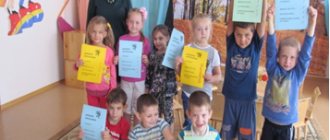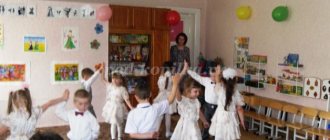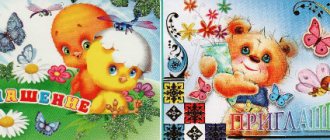Conversation “Uncharted Space”
author: Kireeva Veronika Nikolaevna
Teacher of MBDOU "Kindergarten" Rainbow "combined type" JV "Kindergarten No. 4 combined type" Ruzaevka
Conversation “Uncharted Space”
Conversation on the topic “Cosmonautics Day”
Prepared by: Veronika Nikolaevna Kireeva
Second junior group
Goal: acquaintance with space, the first cosmonaut.
Tasks:
Educational: to form children’s understanding of planet Earth, to introduce the first cosmonaut Yu. A. Gagarin.
Developmental: expand children’s ideas about the profession of an astronaut pilot, stimulate the development of speech, memory, thinking, develop imagination and fantasy.
Educational: to instill respect for the profession of an astronaut, to teach respect for planet Earth.
Progress of the conversation:
(The teacher starts the conversation)
Earth is the planet on which we live, it is the only planet in the solar system on which life exists. People, plants and animals live on Earth because there is water and air. It revolves around the Sun and is the most beautiful and interesting of all the planets. The Sun is the closest star to Earth. Without the Sun there would be no life on Earth. Everything that happens on our planet is connected with the Sun: the change of day and night, the onset of winter or summer. During the day, the sun warms and illuminates our planet. All living things rejoice in sunlight and warmth. With the sunrise, nature awakens and comes to life.
In the evening we can see the moon and stars in the sky. The Moon is the Earth's satellite. It shines brightly in the night sky. People have always wanted to visit the moon, fly to the stars, and see the Earth from space.
— Would you guys like to become astronauts?
—Who are astronauts?
-What do you think an astronaut should be like? (healthy, strong, knowledgeable, hardworking, courageous, resilient, etc.).
-What can you see in the sky? (stars)
- How many stars are there in the sky? (so many)
People wanted to know if there was life on other planets. What creatures live there, are they similar to us, is there air on other planets. But to find out, you must fly to them. Airplanes were not suitable for this. Who knows why? (because the planets are very far away). And so scientists invented the first satellite, installed instruments on it and launched it into outer space. There were two dogs on board - a squirrel and an arrow, they successfully returned to Earth. And then in 1961, the first man went into space.
The first person who was able to go on a space journey was cosmonaut Yuri Alekseevich Gagarin. He made his flight on April 12, 1961 on a Vostok rocket. On this day our country Fr. This is a holiday of astronauts and people who participate in the creation of space rockets.
Physical exercise "Rocket".
One, two - there is a rocket (hands up)
Three, four - airplane (arms to the sides)
One, two - clap your hands
And then on every account.
One, two, three, four - and they walked around in place,
Tick-tock, tick-tock - all day like this (hands on waist, bending to the side)
Didactic game “Family of Words”.
Let's play and form words from one family for the word "star".
- How can you affectionately call a Star? (star)
- If there are many Stars in the sky, then we will say what it is like? (stellar)
- What is the name of the ship that flies to the stars? (starship)
- What do they call a wizard in fairy tales who predicts the future from the stars? (astrologer)
Well done! Today you have learned a lot about space, astronauts, about our planet, and I think that you can be enrolled in the cosmonaut corps.
Summary of the conversation.
Questions:
- What is the name of our planet?
- What is the sun for?
- When can we get a good look at the moon?
- What was the name of the man who first flew into space?
Conversation “Uncharted Space”
Goals:— expand children’s ideas about space flights: introduce them to Russian scientists who were at the origins of the development of Russian cosmonautics, — K.E. Tsiolkovsky, S.P. Korolev;
— consolidate children’s knowledge that the first cosmonaut on Earth was Russian citizen Yuri Gagarin;
— bring to the understanding that only a healthy, educated, persistent and fearless person can be an astronaut;
— to educate children to be proud of their country.
Materials and equipment:
— photographs of cosmonauts, Russian scientists;
— illustrations: “Start of the ship”, “Meeting of Gagarin”;
— photos of dogs — Belki and Strelki.
Educator.
The man looked at the starry sky and he wanted to know what kind of stars they were, why they were so bright? Scientists came up with special instruments - telescopes and, observing the starry sky, they learned that besides the Earth there are other planets - some smaller, others larger. What planets do you know?
The children answer.
Mars, Venus and many others. People wanted to know if there is life on other planets? And if there is, who lives there? Are these living creatures similar to people? But to find out about this, you need to fly to these planets. Airplanes were not suitable for this, because the planets were very far away. And scientists came up with rockets.
Who in Russia invented the first rocket?
The scientist and inventor Konstantin Eduardovich Tsiolkovsky lived in the city of Kaluga. (The teacher shows a portrait of a scientist.) He really loved watching the stars through a telescope, studied them, and he really wanted to find answers to the questions: “Is it possible to build a metal balloon that does not allow gas to pass through and floats forever in the air? Is it possible to fly to other planets using a rocket?” And he decided to design an aircraft that could fly to another planet. He carried out calculations, made drawings and came up with such an aircraft. But, unfortunately, he did not have the opportunity to do it.
And only many, many years later, another scientist-designer - Sergei Pavlovich Korolev (the teacher shows a portrait of the scientist) was able to design and manufacture the first space satellite, in which animals (dogs) first flew around the Earth, and then on April 12, 1961 he flew into space for the first time Human.
Who knows this man's last name? Who was the first astronaut on Earth?
The children answer.
It was Yuri Alekseevich Gagarin. (The teacher shows a portrait of Gagarin, the illustration “Start of the ship.”)
During the launch, flames broke out in the rocket engines; they all started working smoothly and simultaneously. The noise was incredible. But people still heard the kick, Gagarin laughed and said: “Let's go!” And at that same moment the rocket took off and disappeared into the blue sky.
Yuri Alekseevich was the first to see the whole Earth. (The teacher shows a view of planet Earth from space.) Not a piece, not a section, but all at once, entirely - from pole to pole. He flew and looked out the porthole window, and not just mountains and seas, and not just islands and continents floated under him, the whole planet floated and turned under him. In 108 minutes he flew around it. “How beautiful she is!” - Gagarin spoke on the radio to those who remained below.
What do you think an astronaut should be like?
Children's guesses.
First of all, an astronaut must have good health, he must be strong and resilient, because during a space flight a person experiences enormous overloads. Listen to what Yuri Gagarin felt during the world's first space flight. Writer Viktor Borozdin wrote about this.
The rocket rushed further and further from the Earth. Yuri Gagarin was reclining in a chair, unable to even move. The faster the rocket flew, the stronger the pressure on the chair.
The body suddenly became incredibly heavy. Arms, legs, every finger became not our own, as if cast from cast iron. Only a minute of flight passed, but it seemed to Gagarin that he had been flying for an hour. My chest felt tight and it became difficult to breathe.
And from Earth they were already asking on the radio: “How are you feeling?” You have to answer, but saying even one word is also not easy. It's hard to even open your mouth. And yet Gagarin found strength in himself: it was not for nothing that he trained so much before the flight.
“I’m fine, everything’s fine,” he said, “I’m flying normally.” I feel good.
The rocket was shaking. She seemed to be in a hurry to fly to the height that the scientists had indicated to her.
And suddenly it became quiet - the engine stopped working. But the ship was moving at great speed. The cabin no longer shook, and there was less and less pressure on the seat. Suddenly, Yuri felt that he was lifted above the chair, and his body weighed nothing. He raised his hand - it remained raised, raised his leg - it did not fall.
Gagarin wanted to write down his observations in a journal, looked, but the pencil was not there: it was floating around the cabin. He tossed the magazine and it hung in the air.
Gagarin didn’t want to eat or drink yet, but he had to try. After all, food in space also weighs nothing, and who knows if he will be able to swallow it? What if it gets stuck in your throat? On Earth I tried to eat upside down while standing on my hands. It worked. Well, what about here?
Gagarin’s food was special, “cosmic”. From a tube, the kind that toothpaste usually comes in, he squeezed the meat puree directly into his mouth. Swallowed it. Then I squeezed out fruit jam from another tube, and then currant juice. I swallowed everything. It was only when he was drinking juice that he accidentally spilled a few drops, and they floated through the air like black berries...
Educator.
You see how difficult it was for the first cosmonaut. Why do we say that an astronaut must be fearless?
Children's guesses.
Previously, people had never flown into space and did not know what they could encounter there. After all, there could be some malfunctions in the rocket. Therefore, when Yuri Gagarin first flew into space, all our people followed this flight, everyone was worried about the first cosmonaut. And when he landed safely, the whole country rejoiced. People took to the city streets. In Moscow, people gathered in the center, on Red Square, and this celebration continued until late in the evening. We were all proud that it was a Russian citizen who was the first in the world to fly into space.
The teacher shows illustrations of people on Red Square with posters: “Hurray! Gagarin", "Glory to our Motherland!"
After Gagarin's flight, a lot of cosmonauts visited space, including women - the world's first female cosmonaut Valentina Tereshkova and Svetlana Savitskaya. (Shows portraits.)
What astronauts' names do you know?
The children answer.
Alexey Leonov is the first cosmonaut to walk into outer space. (Shows the portrait.)
Many cosmonauts flew into space more than once and worked there for several months. Currently, joint flights are being carried out with cosmonauts from different countries.
Our country appreciated the work of astronauts: all cosmonauts were awarded high awards.
But people don't stop there. They strive to explore everything distant and unknown - new planets and starry distances.
Maybe one of you will also become an astronaut or rocket designer, invent a rocket on which people can travel long distances and discover new planets.
Cosmonautics Day. Conversation in kindergarten. Senior group
Cosmonautics Day in kindergarten.
Author: Bondarenko Ekaterina Nikolaevna, teacher. Place of work: MBU kindergarten No. 49 “Merry notes”, Tolyatti
The theme of space is always interesting for children. Therefore, on April 12, Cosmonautics Day, educators hold holidays, competitions, and educational classes on the topic: Cosmonautics. We invite you to conduct an educational lesson for preschoolers in the form of a thematic conversation.
Thematic conversation for Cosmonautics Day “Man rose to the sky”
Objectives: 1. Generalize and expand children’s knowledge about the Universe. 2. Give an idea about the first cosmonaut, about the significance of Yuri Alekseevich Gagarin’s first flight into space, about the inventor of the space rocket, about the Cosmonautics Day holiday. 3. Form cognitive interests; the concept of oneself as an inhabitant of planet Earth. 4. Activate the vocabulary: sky, stars, planets, satellites, astronaut, Sun, Earth, Moon. 5. Enrich the vocabulary: Galaxy, Universe, Solar system, Mercury, Venus, Mars, Jupiter, Saturn, Uranus, Pluto, weightlessness, orbit, meteorite, spacesuit, lunar rover, orbital station. 6. Develop experimental activities and experimentation. 7. Foster respect and a sense of pride for the achievements of your people, based on specific historical facts. Equipment: paintings depicting the starry sky, outer space, portraits of K. E. Tsiolkovsky, S. P. Korolev and Yu. A. Gagarin, photographs of rocket launches from the Baikonur cosmodrome, photo albums about space explorers. Preliminary work: conversations about stars, planets, space and astronauts. Progress: Educator: - Many centuries passed before humanity found a way to overcome gravity and rise into outer space. Guys, remember the fairy tales and legends. What fairy-tale heroes didn't fly on! (On bats and eagles, on flying carpets and wizards’ beards, on the Little Humpbacked Horse and magic arrows...). Just a few centuries ago, no one could have imagined that the most convenient “transport” for moving around was a rocket. Mini-powder rockets have long been used to create fireworks or send signals in military affairs. In Russia, in the middle of the last century, artillery general K.I. Konstantinov gave the rocket its combat function. Its missiles could cover a distance of up to three kilometers.
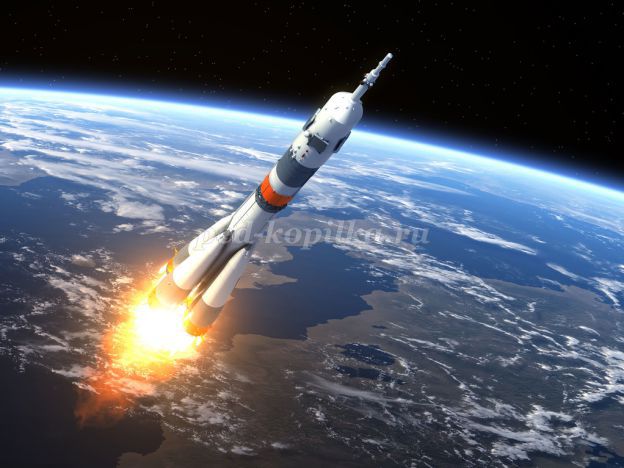
The first who saw in a rocket a projectile capable of carrying earthlings into interplanetary space was the great Russian scientist K. E. Tsiolkovsky. He said this about this: “The earth is our cradle, but you cannot live forever in a cradle.” The rocket does not need air, which means it can fly in the void, in space, and reach enormous speed there. It took a lot of work to create the first rocket. It was built by Russian scientists, workers, and engineers. It was in our country that the first artificial Earth satellite was launched. Guys, do you know who the first astronaut was? What do you know about this person? When was the first space flight made? (The adult listens to the children’s answers and asks clarifying questions).
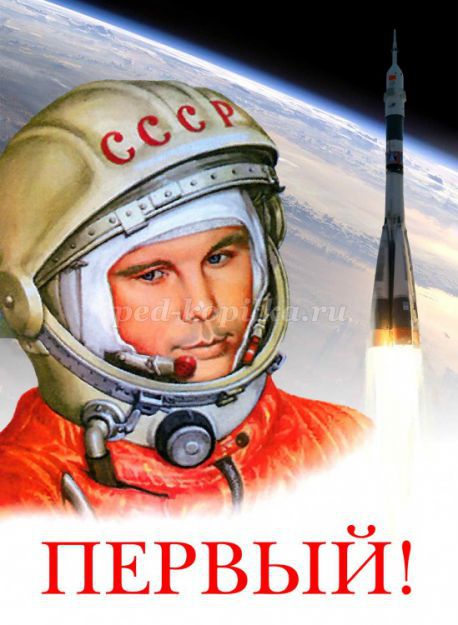
Yuri Alekseevich Gagarin first flew into space on the Vostok-1 spacecraft. His call sign “Cedar” was recognized by all the inhabitants of our planet. Although Gagarin spent only 108 minutes in space, making only one revolution around the Earth, this was only the beginning - the beginning of human exploration of outer space. Half a century has passed since then, but during this time cosmonauts from many countries, both men and women, have been in space. The first human flight into space opened the era of international space stations, the desire to explore the planets closest to Earth - Mars and Venus. Listen to how the poet Alexander Tvardovsky speaks about the day of the first flight into space in his poems. Ah, this day - the twelfth of April, How it swept through people's hearts. It seemed that the world had involuntarily become kinder, shocked by its victory. What kind of universal music he thundered, That holiday, in the motley flame of banners When the unknown son of the land of Smolensk. Was adopted by the Earth-planet. An inhabitant of the Earth, this heroic fellow, In his space vessel In a circular, forever unprecedented manner, In the depths of the sky, he waved above it... Dynamic pause “Cosmonauts” (Demonstration of physical exercises, involving children in their actions). To become an astronaut, children. From a very young age, you need to accustom yourself to order: Make your bed, do physical exercises. Let's stand straight, shoulders wider, Hands up, stay straight. From such exercises you will become stronger and stronger. Today, space flights have become completely commonplace for us, the inhabitants of the Earth. It is believed that the exploration of other planets is not far off. But the beginning of this was laid by our Russian cosmonaut. American astronaut Neil Armstrong, the first earthling to walk on the Moon, said this about Yuri Gagarin’s flight: “He called us all into space.” Show and tell about the planets.
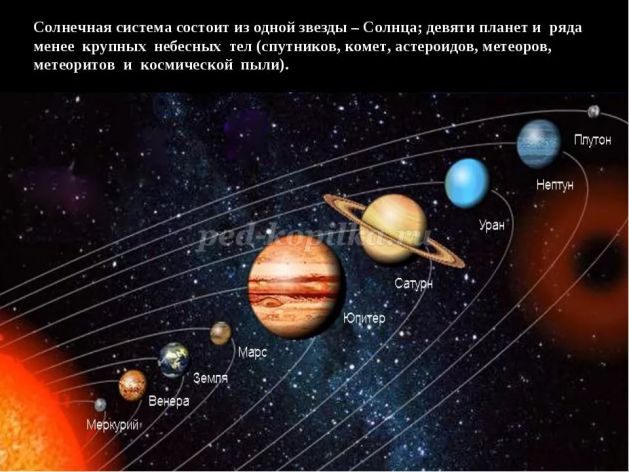
We recommend watching:
Poems and ditties for Cosmonautics Day for kindergarten Scenario of thematic leisure time for Cosmonautics Day in kindergarten Summary of educational activities in the middle group on the topic “Oh, if only I were an astronaut” Design of a preschool educational institution for Cosmonautics Day
Similar articles:
Abstract of GCD in the senior group on the topic: Space
Scenario of thematic entertainment in the middle group for Cosmonautics Day
Sports game competition in the senior group for Cosmonautics Day
Game scenario - quizzes in the preparatory group on the topic "Space"
Summary of GCD in the preparatory group “Space Travel”


